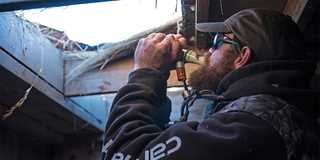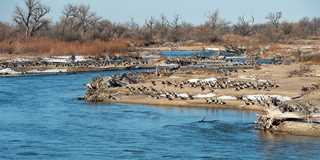Advanced Tactics for Geese
Take your goose hunting to the next level with these 10 tips from the pros
Take your goose hunting to the next level with these 10 tips from the pros
By John Pollmann
A large flock of geese rapidly closing in on your decoy spread is one of the most thrilling sights in waterfowling. But convincing those birds to finish, feet down and within shotgun range, can be a challenge. Savvy hunters use a variety of different strategies and tactics to seal the deal with these wary birds. Here, five of North America's most experienced goose hunters reveal their tried and true methods for honkers, specks, and snow geese.

Photo © JIM THOMPSON
The late Tim Grounds saw a lot of changes during his long career as a champion caller and call maker. During an interview this past summer, a few months before his untimely passing, Grounds shared some of his secrets for success. One of the most effective techniques in his repertoire, he said, was using a flag to bring lifelike motion to his decoy spread.
"Flagging is one of the most important things that I do for geese," Grounds explained. "And flagging is probably more important than anything else when geese are off in the distance. You have to do whatever it takes to get their attention, especially if the wind is blowing the sound of the call away from the birds."
Flagging can also be extremely helpful when convincing birds to commit to those last few yards. "I'll teeter-totter that flag just off the ground to drag those birds the last 15 to 20 yards into the hole," Grounds explained. "Sometimes they need that help closing the gap if they're flying against a big wind or if they want to land just short of the decoys."

Photo © DAYSAFIELDPHOTOGRAPHY.COM
Grounds said it's a good idea to practice calling with those who share a lot of time with you in the blind. "You can learn a lot from others. But more important, once you're in the field, you want to be able to work together as a team so that the calling coming from the blind is as realistic as possible," he said. "Designate someone in the blind to take the lead on each flock. The others in the blind should work to complement, rather than mimic, those sounds."
Weather has a big impact on the daily habits of waterfowl, and Grounds said it can also dictate when hunters should target geese in heavily hunted areas. "When you reach that point in the season when the birds are tough, and they've gone into a pattern of feeding only at night, or they come out to feed just after legal shooting hours, you want to keep a close eye on the forecast," Grounds explained. "You're going to want to find yourself in the decoys when there's a change in the weather pattern, especially if it involves cold or snow, because the birds are going to move."
While Rich-N-Tone staff member Shawn Stahl is a world goose calling champion, he finds himself returning to the basics when it comes to enticing Canada geese into shooting range.
"It all started with learning how to make a cluck, and that call is the foundation of much of what I use while hunting," Stahl said. "I can get a lot of reactions from the birds by using just that sound."
Eliciting a response from geese with a call is all about pitch, cadence, and tempo, and a simple cluck can be easily modified. "I can stretch the sound into a honk to get the attention of passing birds," Stahl explained. "And then I can gradually increase the speed and make a higher-pitched cluck to get an agitated or excited sound that sometimes provokes a conversation with the birds in the air."
The first step in a successful goose hunt is being in the right place, though not every good hunt takes place on the X. "If you can be exactly where the birds want to be, great, but sometimes that's not possible," Stahl said. "You need to have a backup plan. Maybe that's a place in between a roost area and the X, or another spot in a flight path where you can convince the geese that this is a place where they wouldn't mind spending some time."
White-fronted geese are extremely vocal. According to veteran guide Trevor Manteufel, the sounds the birds produce in the field provide a perfect template for how hunters should approach their calling. "Whether I'm running traffic or I'm in a hot field, the most effective calling is what I hear when I listen to real birds," he said. "As impressive as the things you hear online can be, you don't have to do the fancy yodels or the ground clucking that sounds like a massive feed of happy birds. Keep things simple, especially if you're just learning to blow a speck call. Forget about trying to sound like a bunch of geese. Learn the two- and three-note yodels. Those sounds are enough to put birds in the decoys."
Similar to Canada geese, white-fronted geese will occasionally go quiet, but a little calling is usually enough to get them fired up and talking back. "With every flock, the most important thing is to watch the reactions of the birds," Manteufel added. "They will let you know what they like to hear."

Photo © DAYSAFIELDPHOTOGRAPHY.COM
For Utah hunter Brad Conrad, late-season Canada goose hunting means searching for open water. When he finds it, he nearly always finds geese as well. From there, he can begin to pattern the birds and maybe follow them to a field, but he prefers to figure out a way to hunt right there on the water.
"Sometimes you have to create your own pockets of water, which is why my favorite piece of gear for the late season is an ice eater," said Conrad, who is a member of the Hard Core Decoys pro staff.
Conrad's late-season decoy setups often include a large number of sleeper shells that he places on the ice shelf around open water, with full-body sentry decoys mixed in for added visibility. He also places a few floating decoys in the open hole for an extra degree of realism. "The idea is to paint a picture for these geese that this patch of open water is safe and it's a good place to spend the day loafing around," he said.
As significant as location, calling, and decoys are for late-season hunts, it's also important to pay attention to hunter comfort. According to Conrad, this means wearing appropriate layers of clothing, having a heater in the blind, and bringing along plenty of warm drinks and food.
"With late-season geese, some days they fly in the morning, some days they fly midday, and other days they don't fly until late in the afternoon," Conrad said. "If you're not warm and comfortable and prepared to stay out in the blind all day, you might miss the flight completely."

Photo © DOUGSTEINKE.COM
Hunting Canada geese over water is also a favorite method for Ducks Unlimited TV cohost Field Hudnall, especially in the first few weeks of the season. "Early-season geese can be really tough to hunt in fields, but for some reason the birds are more sociable and willing to decoy over water during this part of the season," he said.
Hudnall does not target geese on a roost, but instead sets up on a body of water along the flight path and works to attract passing flocks of birds to his decoys. His water hunts typically involve large spreads of decoys, but he says small-water setups can also be effective.
"If I can find a small pond in a flight path, I'm going to pack it full of decoys and plan on a good hunt. Geese just love those small-water spots," Hudnall explained. "Small water or big, my setup is going to send a message that the birds on the ground feel safe and content, and that this is a place that other geese should stop and visit."
Calling Canada geese over water is similar to calling in a field setup, Hudnall explained. Every flock is different. One technique that seems to work with some consistency involves holding off on any calling until a flock has completely passed over the decoy spread.
"After they pass over, we'll hit them with some excited calling. Not necessarily a lot of calling, but excited sounds, which seems to create some confusion," Hudnall said. "The geese pass over and then hear all this excitement, and maybe the lead birds think that some of the birds behind them have dropped in for a closer look. A lot of times you can get the flock to make a swing, or maybe you'll be able to break off a few birds. If you're lucky, you'll have a bunch of big geese, feet down over the water, 20 yards off the end of your barrel. It's an awesome sight."
Ducks Unlimited uses cookies to enhance your browsing experience, optimize site functionality, analyze traffic, and deliver personalized advertising through third parties. By continuing to use this site, you agree to our use of cookies. View Privacy Policy